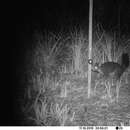en
names in breadcrumbs


Trichosurus cunninghami was not described as a separate species from Trichosurus caninus until 2002.
Like other possums, Trichosurus cunninghami relies on sight, hearing, touch, smell, and taste. Its whiskers enhance it's perception.
Communication Channels: visual ; tactile ; acoustic ; chemical
Other Communication Modes: scent marks
Perception Channels: visual ; tactile ; acoustic ; chemical
The conservation status of Trichosurus cunninghami is of least concern, according to the IUCN, and populations are considered stable.
US Federal List: no special status
CITES: no special status
State of Michigan List: no special status
Mountain brushtail possums are sometimes described as a destructive pest in southeastern Australian pine plantations (IUCN Red List).
Negative Impacts: crop pest
Trichosurus cunninghami does not appear to be of positive economic importance to humans.
Mountain brushtail possums may influence vegetation community structure through their herbivory. Allergic reactions to ectoparasites on the skin may be one of the main causes of the disease 'rumpwear' in mountain brushtail possums (Hufschmid, Handasyde, and Beveridge, 2010).
Mountain brushtail possums are herbivorous and frugivorous. They mainly eat acacia leaves, fungi, lichens, buds, fruit, and sometimes bark. Acacia is an integral part of their seasonal diet, with different species of the plant consumed at different times of the year.
Plant Foods: leaves; wood, bark, or stems; fruit; bryophytes; lichens
Other Foods: fungus
Primary Diet: herbivore (Folivore )
Mountain brushtail possums, or southern bobucks, are native to southeastern Australia, ranging from Victoria to Central Queensland.
Biogeographic Regions: australian (Native )
Mountain brushtail possums are semi-arboreal marsupials found in wet sclerophyll forests of southeastern Australia (Lindenmayer, Dubach, and Viggers, 2002). They usually live in above-ground dens (either tree hollows or nest boxes). A recent study by J.K. Martin found that adult bobucks use multiple den-trees. However, they also occasionally den in thick ground vegetation (Martin, 2006). Due to logging, farming, and other human activities, the primary habitat of most populations is now fragmented forest in agricultural land (Martin and Handasyde, 2007).
Range elevation: 0 to 1300 m.
Average elevation: 300-1300 m.
Habitat Regions: temperate ; terrestrial
Terrestrial Biomes: forest ; scrub forest
Both male and female mountain brushtail possums appear to be long-lived, reaching at least 12 years of age. However, it appears as though fewer males reach that age than females (Martin and Handasyde, 2007). They are perhaps the longest lived marsupial (Viggers and Lindenmayer, 2002).
Range lifespan
Status: wild: 12 (high) years.
Mountain brushtail possums are medium-sized (2.6 to 4.2 kg) marsupials. They have thick, light gray-brown fur, and long, dark gray, bushy tails. They differ morphologically from their close relatives, short-eared possums (Trichosurus caninus), which is found directly to the north of mountain brushtail possums. No sexual dimorphism is apparent (Lindenmayer, Dubach, and Viggers, 2002).
Range mass: 2.5 to 4.5 kg.
Range length: 81 to 93 cm.
Other Physical Features: endothermic ; homoiothermic; bilateral symmetry
Sexual Dimorphism: sexes alike
Mountain brushtail possum predators have not been well-reported. They are preyed on by non-native foxes (Vulpes vulpes) and may also be taken by large snakes or raptors. The main threat to populations is human action – the clearance of land for forestry and agriculture.
Known Predators:
Mountain brushtail possums appear to be socially monogamous. Adults are strongly paired and remain very close to each other, staying in the same den on approximately 70% of the days during mating season. Females form a pair-bond at 2 to 5 years of age and the bonds only end at the death of one pair member. However, genetic evidence suggests that mountain brushtail possums are not monogamous; molecular paternity analysis has shown that 35% of young result from extra-pair copulations. Males that sired more than one offspring a year, outside of the pair bond, are generally larger, indicating that dominance results in reproductive success. Mountain brushtail possums have a short, synchronous breeding season. Females have one young per year. Young are in the pouch for approximately 6 months, and then spends 1 to 2 months riding on its mother’s back. Males play almost no part in raising the young (Martin, Handasyde, Taylor, and Coulson, 2007).
Mating System: monogamous ; polygynous
Mountain brushtail possums breed once yearly, in January and February. Offspring remain in the pouch for approximately 6 months and then ride on their mother’s back for another 1 to 2 months. Offspring are usually weaned around September. Juveniles remain close to their mothers until they are approximately 18 months old. Females become sexually mature between 2 and 5 years of age; males between 2 and 3 years (Martin, Handasyde, Taylor, and Coulson, 2007).
Breeding interval: Mountain brushtail possums breed once yearly.
Breeding season: The breeding season is January to February.
Range number of offspring: 0 to 1.
Average number of offspring: 1.
Range gestation period: 15 to 17 days.
Range weaning age: 5 to 6 months.
Range time to independence: 17 to 18 months.
Range age at sexual or reproductive maturity (female): 2 to 5 years.
Range age at sexual or reproductive maturity (male): 2 to 3 years.
Average age at sexual or reproductive maturity (male): 3 years.
Key Reproductive Features: iteroparous ; seasonal breeding ; gonochoric/gonochoristic/dioecious (sexes separate); sexual ; viviparous
Most mountain brushtail possum females give birth to one baby a year. The offspring spend approximately 6 months in the pouch, then 1 to 2 months riding on the mother’s back. Males spend the least amount of time with their female partners when the females are carrying young on their back, and are therefore much less involved in the care of offspring. Juveniles remain with their mothers until they are approximately 18 months old.
Parental Investment: female parental care ; pre-fertilization (Provisioning, Protecting: Female); pre-hatching/birth (Provisioning: Female, Protecting: Female); pre-weaning/fledging (Provisioning: Female, Protecting: Female); pre-independence (Protecting: Female); post-independence association with parents; extended period of juvenile learning